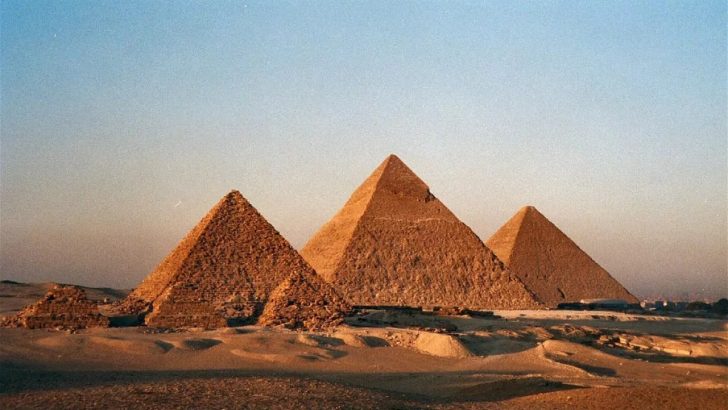Researchers Claim ‘Underground City’ Beneath Giza Pyramids – But Experts Cry Foul
A group of researchers say they have discovered something massive beneath the Giza Pyramids. Using satellite radar technology, they claim to have mapped out eight huge shafts stretching 2,100 feet below ground. These vertical shafts, about 33 to 39 feet wide, supposedly lead to large cube-shaped chambers connected by tunnels.
They believe these chambers form an underground complex that could be ten times the size of the Giza Pyramids above. The team also suggests there may be spiral staircases and ancient water systems inside. To them, this all points to a forgotten underground “city” that could change what we know about ancient Egypt.
Their theory even touches on ancient legends like the “Halls of Amenti” and suggests links to a lost civilization that predates the pyramids by tens of thousands of years.
Technology That Doesn’t Add Up
The team behind the discovery used Synthetic Aperture Radar (SAR), which involves scanning the earth from space. But experts in the field say this technology has serious limits. According to them, SAR can’t see thousands of feet underground. At best, it can detect shallow features just beneath the surface.

GTN / Many scientists believe the underground city claims stretch the truth. They say the radar data simply can’t support such deep findings.
Without ground verification or physical excavation, they argue, the supposed underground city is more of a theory than a fact. And without solid science to back it up, it is hard for the academic community to take it seriously.
Egyptian Authorities Push Back
Egypt’s top archaeological officials are also skeptical. They say there is no evidence of this underground complex, and no excavation has ever uncovered anything close to what is being described. The government has not given any permission for new digs under the Giza Pyramids based on these radar claims.
Former antiquities leaders call the claims unscientific and lacking basic research steps. They point out that real discoveries require fieldwork, permits, and peer-reviewed studies. Without those, the radar images and big theories don’t carry much weight.
As it stands, Egyptian authorities remain firm that there is no vast hidden city beneath the pyramids.
Fringe Theories and Online Buzz
The story has quickly gone viral online, especially on platforms where ancient mysteries and conspiracy theories tend to thrive. Many fans are linking the supposed structures to ancient power grids or alien technology. Some are connecting the story to UFO researcher Corrado Malanga’s past work, which includes controversial theories on extraterrestrial contact.

Eca / The discovery is gaining more attention in alternative history circles than in scientific ones. Scholars argue that connecting the find to lost civilizations and mythical structures crosses the line into fiction.
While it is easy to get caught up in dramatic possibilities, the academic community warns that science needs real-world proof – not just radar images and legends.
No Excavation & No Proof So Far
Right now, everything depends on getting physical access to the site. Without permission from Egyptian authorities to dig, no one can verify if the structures even exist. Satellite data alone is not enough to confirm what is under the sand. That is why researchers are pushing for approval to carry out fieldwork and hopefully prove their theory.
But until someone actually starts digging, the so-called underground city remains just a claim. And with no peer-reviewed study or public release of full radar data, the scientific community is treating it with caution. In archaeology, bold ideas can be exciting. But they don’t mean much without facts on the ground.